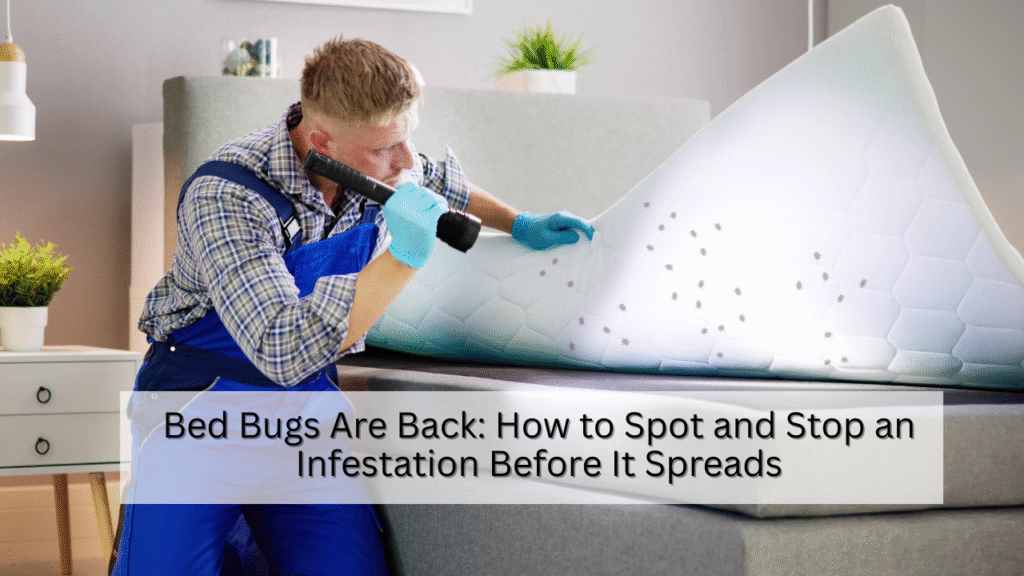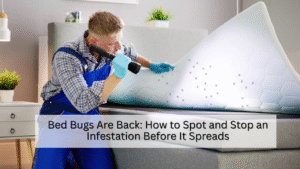It starts with a small red bite on your arm. Then another one on your leg. You brush it off as a mosquito bite, until you notice the tiny spots on your bedsheet.
That’s when it hits you: it might be bed bugs.
It’s not your fault. Bed bugs don’t show up because your home is dirty. They show up because they’re hitchhikers, and they’re very good at it.
From hotels and buses to movie theatres and apartment buildings, bed bugs spread silently. Once they make it inside, they’re hard to get rid of without a plan.
So, let’s talk about how to spot them early, what really kills them, and how to stop them before they take over your home.

What Bed Bugs Actually Are
Bed bugs are small, flat, reddish-brown insects, about the size of an apple seed.
They feed on blood (mostly at night) and hide during the day in tiny cracks and seams.
They don’t fly or jump, but they crawl fast. And because they can survive for months without food, simply leaving a room empty doesn’t make them go away.
They’re sneaky, quiet, and excellent at hiding, that’s what makes them such tough pests to handle.
Where Bed Bugs Hide in Your Home
You’d think bed bugs only live in beds. They don’t.
Yes, they prefer to hide near where you sleep, but once they settle in, they spread quickly through:
- Mattress seams and box springs
- Headboards and bed frames
- Baseboards and electrical outlets
- Curtains and couches
- Luggage, backpacks, and clothing
Basically, if there’s a dark, narrow space, they can hide in it.
In apartment buildings or condos, they can even crawl through electrical lines or vents to reach new units.
How Bed Bugs Get In
Bed bugs don’t appear out of nowhere. They travel usually by accident.
You might bring them home after:
- Staying at a hotel or Airbnb
- Buying used furniture
- Riding public transit
- Visiting someone who already has them
They climb onto clothes, bags, or even shoes, then hide until nighttime.
One pregnant female bed bug can start a whole new colony, laying up to 500 eggs in her lifetime.
That’s why catching them early matters.
How to Tell if You Have Bed Bugs
The earlier you find them, the easier it is to eliminate them.
Here’s what to look for:
1. Small Red Bites
Bed bugs usually bite exposed skin: arms, legs, neck, or back.
Their bites often appear in a straight line or cluster and can itch or swell slightly.
(But remember: not everyone reacts the same way, so bites alone aren’t proof.)
2. Rust-Colored Stains
You might see tiny reddish-brown spots on sheets, pillows, or mattress corners.
Those are either crushed bugs or dried blood after feeding.
3. Black Dots
Small black specks along mattress seams or wall edges are droppings, a clear sign they’ve been feeding.
4. Shed Skins and Eggs
Bed bugs shed their outer skin as they grow. You might spot these pale, empty shells near cracks or mattress tags.
5. Musty Smell
In heavy infestations, you might notice a sweet, musty odor, kind of like old fruit or wet towels.
If you notice two or more of these signs, don’t wait. Bed bugs multiply fast and every week you wait makes it harder to contain.
Why You Shouldn’t Try to Handle It Alone
It’s tempting to buy a can of spray or fogger, but here’s the truth:
Most over-the-counter products kill only the bugs you see. The eggs and hidden ones stay safe and come back stronger.
Worse, bed bugs can develop resistance to common chemicals.
That’s why spraying randomly or using bug bombs doesn’t work, it just drives them deeper into the walls.
Real success comes from precision: identifying where they hide, using the right treatment method, and monitoring until they’re truly gone.
What Actually Works Against Bed Bugs
There’s no single magic spray but there are proven treatments that professionals use.
1. Heat Treatment
This is the most effective and eco-friendly method.
Bed bugs and their eggs die when exposed to temperatures above 120°F (around 50°C).
Technicians use specialized heaters to raise the temperature evenly in all corners including mattresses, walls, and furniture.
It’s safe, chemical-free, and kills all life stages in one go.
2. Steam Treatment
For smaller infestations, high-temperature steam is used on mattresses, upholstery, and carpets.
It’s ideal for homes with children or pets and works best when combined with vacuuming and inspection.
3. Insecticide Application
In some cases, professionals use targeted insecticides applied only in cracks, baseboards, or behind outlets where bugs hide.
It’s not about spraying everywhere. It’s about applying the right amount in the right place.
4. Vacuuming and Encasements
Vacuuming removes live bugs and eggs from exposed areas. After treatment, mattresses are often sealed in bed bug-proof covers to trap any survivors.
5. Monitoring and Follow-Up
Bed bug treatments usually need at least two visits to confirm full elimination.
Professionals use traps or detectors to check for new activity before calling it clear.
DIY Tips That Help (and Don’t Make It Worse)
If you’re waiting for professional help or dealing with a light issue, you can do a few things to limit spread:
Wash and dry all bedding, linens, and clothes on high heat for at least 30 minutes.
Vacuum thoroughly including mattress seams and baseboards — then dispose of the vacuum bag outside.
Declutter to reduce hiding spots.
Avoid moving infested furniture between rooms — it only spreads the problem.
Avoid: bug bombs, essential oils, or home-made chemical mixes. They rarely work and can be unsafe indoors.
How to Prevent Bed Bugs in the Future
The best defense is awareness. Once you know where they come from, it’s easier to stop them.
1. Inspect Hotel Rooms
When you travel, pull back the sheets and check the mattress seams for small black dots or stains.
Keep your luggage on a stand — not the floor.
2. Clean After Travel
As soon as you get home, wash travel clothes in hot water and vacuum your suitcase.
3. Be Careful with Used Furniture
Inspect second-hand items closely, especially sofas, headboards, and mattresses.
If you’re unsure — skip it. A free couch isn’t worth an infestation.
4. Regular Home Checks
Look behind headboards, near outlets, and under cushions every few months.
If you rent or live in shared housing, check more often — bed bugs can move between units.
Why Bed Bugs Are Coming Back in Canada
Bed bugs nearly disappeared in Canada decades ago thanks to widespread pesticide use. But they’ve made a comeback.
Why? Because global travel increased, and modern chemical restrictions made older sprays illegal.
Now, they thrive in cities like Toronto, Mississauga, and Ottawa — where apartments, hotels, and condos give them plenty of places to hide and spread.
The good news? Professional pest control companies like BugManagers have modern, safe, and highly effective solutions that don’t rely on harsh chemicals.

When to Call a Professional
If you’ve spotted bed bugs — even a few — act fast.
A small problem can turn into hundreds within weeks.
Call a professional if:
- You find bites and stains regularly
- DIY efforts haven’t worked
- You’re living in a shared building
- You see bed bugs in more than one room
At BugManagers, we handle bed bug removal across Ontario using a mix of heat, steam, and precision treatments.
Our technicians inspect every corner, treat affected areas safely, and follow up to make sure they’re completely gone.
You’ll get practical guidance on prevention too — so they don’t come back
Final Thoughts
Dealing with bed bugs is stressful — but it’s fixable.
You don’t have to throw out your furniture or feel embarrassed. It’s not about cleanliness. It’s about awareness and quick action.
Start by checking your bed, identifying the signs, and calling for help before they spread.
A proper inspection and treatment can turn a nightmare into just another story you tell later — not one you’re still living.
At BugManagers, we know how disruptive bed bugs can be. That’s why we focus on fast, discreet, and effective removal, with minimal disruption to your life.
Because everyone deserves a good night’s sleep — without the bites.







